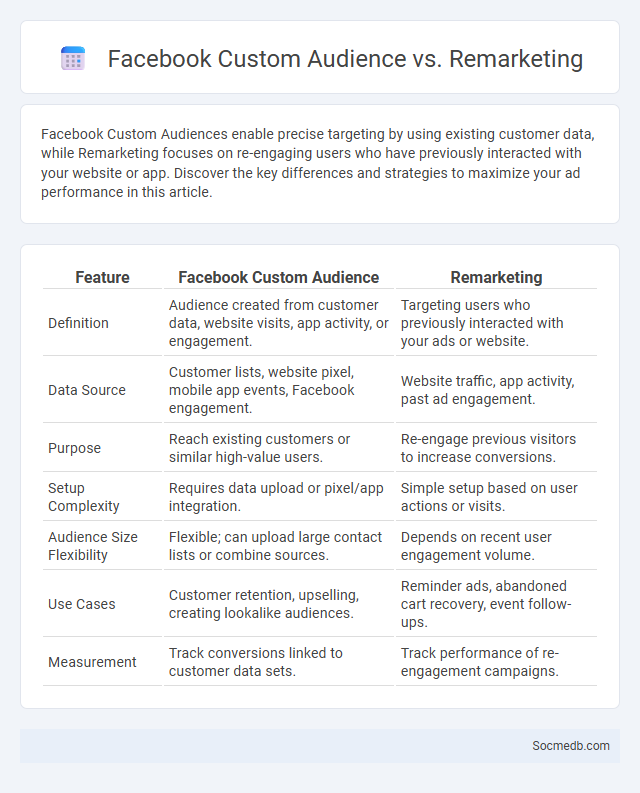
Photo illustration: Facebook Custom Audience vs Remarketing
Facebook Custom Audiences enable precise targeting by using existing customer data, while Remarketing focuses on re-engaging users who have previously interacted with your website or app. Discover the key differences and strategies to maximize your ad performance in this article.
Table of Comparison
| Feature | Facebook Custom Audience | Remarketing |
|---|---|---|
| Definition | Audience created from customer data, website visits, app activity, or engagement. | Targeting users who previously interacted with your ads or website. |
| Data Source | Customer lists, website pixel, mobile app events, Facebook engagement. | Website traffic, app activity, past ad engagement. |
| Purpose | Reach existing customers or similar high-value users. | Re-engage previous visitors to increase conversions. |
| Setup Complexity | Requires data upload or pixel/app integration. | Simple setup based on user actions or visits. |
| Audience Size Flexibility | Flexible; can upload large contact lists or combine sources. | Depends on recent user engagement volume. |
| Use Cases | Customer retention, upselling, creating lookalike audiences. | Reminder ads, abandoned cart recovery, event follow-ups. |
| Measurement | Track conversions linked to customer data sets. | Track performance of re-engagement campaigns. |
Understanding Facebook Custom Audiences
Facebook Custom Audiences enable you to target specific groups of users by leveraging data such as email addresses, phone numbers, and website traffic, enhancing the precision of your ad campaigns. By uploading customer lists or using Facebook Pixel, you can create highly relevant segments to deliver personalized ads that improve engagement and conversion rates. Understanding this tool helps maximize the efficiency of your marketing budget by reaching people most likely to respond to your offerings.
What is Remarketing?
Remarketing is a digital advertising strategy that targets users who have previously interacted with a brand's website or social media content by showing them tailored ads across various platforms. This technique uses cookies and tracking pixels to track user behavior, enabling businesses to re-engage potential customers and increase conversion rates. By delivering personalized messages to warm audiences, remarketing enhances brand recall and drives higher return on ad spend (ROAS).
Custom Audience: Definition and Types
Custom Audience is a marketing tool used on social media platforms like Facebook and Instagram that allows advertisers to target specific groups of users based on their previous interactions with a business. Types of Custom Audiences include website traffic audiences, app activity audiences, customer list audiences, and engagement audiences, each defined by user behavior such as visiting a site, using an app, providing contact information, or engaging with content. These audiences enable precise ad targeting, improving campaign relevance and return on investment.
Key Differences Between Custom Audiences and Remarketing
Custom Audiences allow you to target specific user groups based on their existing interactions with your brand, using data like email addresses or phone numbers. Remarketing targets users who have previously visited your website or used your app, serving ads that encourage them to return and complete a desired action. Understanding these differences helps you refine Your social media advertising strategy for more effective audience engagement and conversion.
How Facebook Custom Audiences Work
Facebook Custom Audiences work by allowing advertisers to target specific groups of users based on data collected from customer interactions, such as website visits, app activity, or email lists. This data is matched with Facebook profiles to create highly relevant ad campaigns, enabling precise targeting for increased engagement and conversion. By leveraging pixel tracking and hashed customer information, advertisers can efficiently reach existing customers or lookalike audiences with tailored marketing messages.
Benefits of Using Remarketing in Your Strategy
Remarketing in your social media strategy enhances audience targeting by re-engaging users who have previously interacted with your content or website, increasing conversion rates significantly. This approach leverages data-driven insights to deliver personalized ads, boosting brand recall and improving ROI on ad spend. You benefit from reaching a highly relevant audience, optimizing your marketing budget while driving higher engagement and sales.
Custom Audiences vs. Lookalike Audiences
Custom Audiences enable advertisers to target specific groups of users based on existing customer data such as email lists or website visits, ensuring precise engagement with known audiences. Lookalike Audiences leverage algorithms to find new potential customers who share similar traits and behaviors with Custom Audiences, expanding reach efficiently. The strategic use of Custom Audiences drives high relevance and conversion rates, while Lookalike Audiences optimize campaign scalability and market penetration.
Best Practices for Audience Segmentation
Audience segmentation in social media marketing maximizes engagement by dividing followers into precise groups based on demographics, interests, and behavior patterns. Utilizing data analytics tools to analyze user interactions and preferences ensures tailored content delivery, increasing conversion rates and brand loyalty. Continuous testing and refining segmentation criteria optimize targeting strategies, enhancing overall campaign performance.
Choosing the Right Strategy: Custom Audience or Remarketing?
Choosing the right social media strategy depends on Your marketing goals and audience behavior; Custom Audience targets users based on specific data like email lists or website visits, creating highly personalized campaigns that boost engagement. Remarketing focuses on re-engaging users who have already interacted with Your brand, encouraging conversions through tailored ads that remind them of their interest. Understanding Your customer journey and analyzing campaign performance data ensures the optimal balance between Custom Audience targeting and Remarketing for maximum ROI.
Measuring Success: Metrics for Audience Targeting
Measuring success in social media audience targeting relies heavily on key performance indicators such as engagement rate, click-through rate (CTR), and conversion rate. Tools like Google Analytics and native platform insights provide granular data on user interactions, enabling precise adjustments to targeting strategies. Monitoring metrics like reach, impressions, and follower growth also delivers critical insights into campaign efficacy and audience resonance.
 socmedb.com
socmedb.com